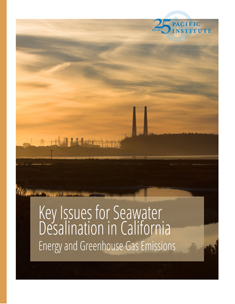Key Issues in Seawater Desalination in California: Energy and Greenhouse Gas Emissions

Key Issues in Seawater Desalination in California: Energy and Greenhouse Gas Emissions
California’s water supply is vulnerable to seasonal extremes that are exacerbated by the effects of climate change. Seawater desalination is a reliable source of water, which can be especially valuable during a drought. Yet in California, and in other regions dependent on hydropower, electricity prices tend to rise during droughts, when runoff, and thus power production, is constrained and electricity demands are high. This report describes the energy requirements and associated greenhouse gas emissions for desalinated water and evaluates the impact of short- and long-term energy price variability on the cost of desalinated water. This report is part of a series launched in 2012 identifying the key outstanding issues for desalination in the state: cost and financing; energy use and associated greenhouse gas emissions; and marine impacts.
Interactive Map: Existing Seawater Desalination Plants in California, December 2015 Interactive Map: Proposed Seawater Desalination Plants in California, December 2015
Overview
Resources
In this Series

